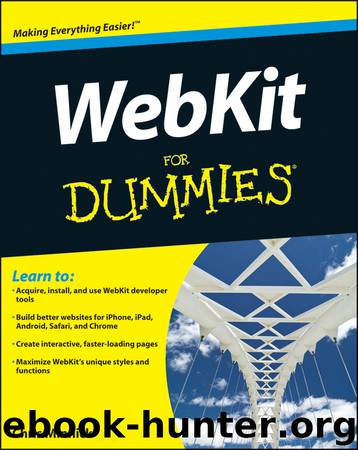WebKit For Dummies by Chris Minnick

Author:Chris Minnick
Language: eng
Format: epub
Publisher: For Dummies
Published: 2012-01-22T16:00:00+00:00
Chapter 9
HTML5
In This Chapter
Introducing HTML5
Comparing HTML5 with XHTML and HTML 4
Using HTML5 new elements
Using HTML5 APIs
HTML5 is the next version of the HyperText Markup Language, which gives structure to the Web. In this chapter, I’ll quickly run though how we got to HTML5, talk about what makes it so great, and then jump in to some actual code examples so you can see some pretty cool new technologies that are possible with HTML5 in many of today’s desktop and mobile browsers (including, of course, WebKit browsers).
Understanding How We Got to 5
On WebKit browsers — therefore, on most mobile devices — HTML5 is ready to use right now. In fact, if you’ve followed this book along to this point from the beginning, you’ve already used it quite a bit in this book.
HTML5 isn’t just one thing. It’s actually a bunch of different languages and standards that you can pick and choose from as you develop your web applications. This is great news because it means that you can use parts of HTML5 today even though other parts aren’t quite ready for prime time yet.
The road to this point has been long, and it hasn’t always been smooth.
The early years
This chapter isn’t meant to be a complete guide to HTML5. I’m going to skip talking about an awful lot of technologies that led up to HTML, the people and organizations that made it possible, the debates and discussions, the early web browsers, the formation of standards organizations and the rest (plenty of other great books cover this stuff in detail), and focus on just a couple of key aspects of HTML and HTML5 to show you why I’m so jazzed about them.
The little language that could
Back in the late ’80s and early ’90s, HTML was designed by some academic types to be a document markup language for scientific papers. HTML was used to “mark up” the different parts of documents and show their structure.
For example, a document has a header with a title inside it, a body with paragraphs in it, and so forth. These are shown using “tags” — simple codes inside of brackets. For example, the p tag in HTML stands for “paragraph.”
To indicate that some text should be formatted as a paragraph, you simply put it inside a beginning tag (<p>) and an ending tag (</p>), as shown in Listing 9-1.
Listing 9-1: A Paragraph of Text
<p>The beginning tag, the text, and then the closing tag, when considered as a whole, are called an element. An HTML document may be made up of many individual elements nested together.</p>
The beginning tag, the text, and then the closing tag, when considered as a whole, are called an element. An HTML document may be made up of many individual elements nested together.
A web browser’s job is to look for tags and follow a set of rules about what to do when it encounters them.
Figure 9-1 shows a diagram of a simple HTML page. Notice that every part of it has an equivalent in the pre-web paper world.
Download
This site does not store any files on its server. We only index and link to content provided by other sites. Please contact the content providers to delete copyright contents if any and email us, we'll remove relevant links or contents immediately.
The Mikado Method by Ola Ellnestam Daniel Brolund(20724)
Hello! Python by Anthony Briggs(20010)
Secrets of the JavaScript Ninja by John Resig Bear Bibeault(18332)
Dependency Injection in .NET by Mark Seemann(18209)
The Well-Grounded Java Developer by Benjamin J. Evans Martijn Verburg(17688)
OCA Java SE 8 Programmer I Certification Guide by Mala Gupta(17496)
Kotlin in Action by Dmitry Jemerov(17308)
Adobe Camera Raw For Digital Photographers Only by Rob Sheppard(16937)
Algorithms of the Intelligent Web by Haralambos Marmanis;Dmitry Babenko(16319)
Grails in Action by Glen Smith Peter Ledbrook(15467)
Test-Driven iOS Development with Swift 4 by Dominik Hauser(10417)
Becoming a Dynamics 365 Finance and Supply Chain Solution Architect by Brent Dawson(8056)
Microservices with Go by Alexander Shuiskov(7820)
Practical Design Patterns for Java Developers by Miroslav Wengner(7723)
Test Automation Engineering Handbook by Manikandan Sambamurthy(7672)
Angular Projects - Third Edition by Aristeidis Bampakos(7160)
The Art of Crafting User Stories by The Art of Crafting User Stories(6611)
NetSuite for Consultants - Second Edition by Peter Ries(6534)
Demystifying Cryptography with OpenSSL 3.0 by Alexei Khlebnikov(6305)
